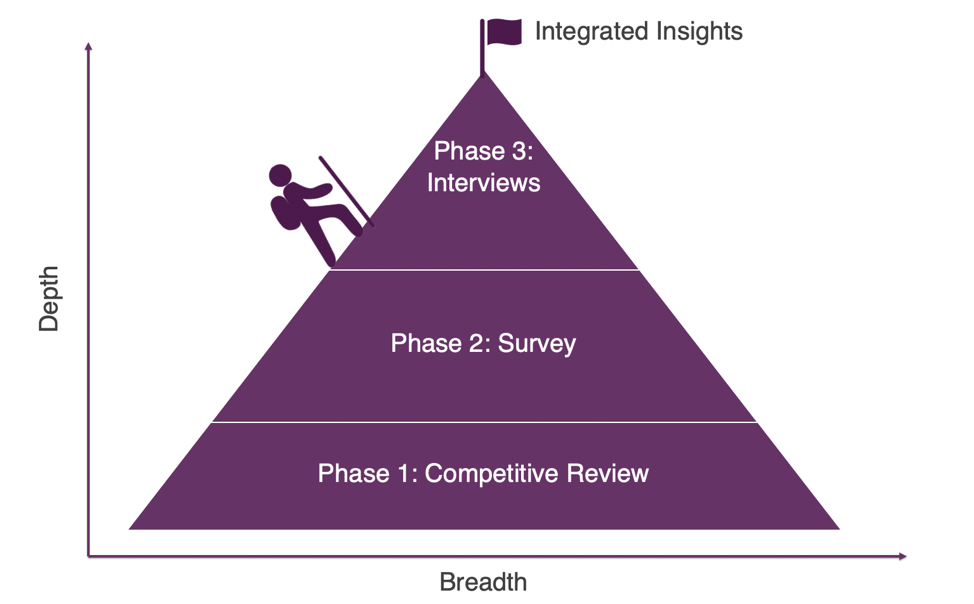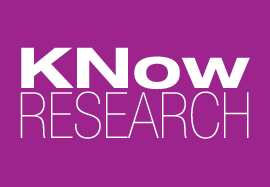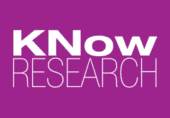Case Study: 3-stage Approach to Defining Unique Benefits
KNow Research’s annual pro bono project focused on the needs of caregivers. We worked with Leeza’s Care Connection, a non-profit organization founded by Leeza Gibbons, whose mission is to help families of Alzheimer’s and dementia patients cope through tips, strategies, and support. Specifically, we conducted research in support of its HUGS (Helping U Grow Stronger) program. The HUGS program trains volunteers, all former caregivers who have walked the path of family caregiving, to be ambassadors who are available and accessible to share their wisdom with others new to the journey.
Our research uncovered the benefits that set HUGS apart from other caregiving support organizations. The clarity on these unique benefits will help HUGS position their program, communicate it across their engaged population and create messages to expand their outreach, opportunities and partnerships.
Watch more about HUGS here: https://youtu.be/BAO7fr0Oh2o
BACKGROUND
The impact of caregiving responsibilities on caregivers are vast, contributing to mental and physical health problems, such as increased stress and social isolation. According to “The Caring Company: How Employers Can Cut Costs and Boost Productivity by Helping Employees Manage Caregiving Needs”: “Workers of all ages and levels of seniority are affected. Given the lack of support at work, many employees hide the growing burden of caregiving responsibilities. They struggle to balance the responsibilities of work and caregiving, often dealing with the unexpected and recurring care obligations that require mental, physical, and financial . resources to address them.” In fact, 73% of employees are caregivers, making care for caregivers a priority for businesses and organizations like HUGS vital to the communities they serve.
METHODOLOGY
Our research was comprised of 3 phases: a competitive review, a survey, and interviews with HUGS volunteers and members of Leeza’s Care Connection community. This multi-phase approach allowed each phase to build upon learnings in the previous phase and gave a 360-degree view on how HUGS compares to other organizations, program satisfaction, and the impact it makes on the caregiving community, all of which are being used to help the program expand and reach more of those who need it.
- COMPETITIVE SET REVIEW Reviewed publicly-available secondary data to analyze competitive program positioning/benefits of other compassion fatigue resources
- SURVEY: Administered a survey to members of the Leeza’s Care Connection community to understand benefits of the HUGS program (for those involved with HUGS) and appeal (for those who aren’t involved with HUGS), to find out what makes HUGS unique, valuable, and/or attractive
- INTERVIEWS: Identified 10 survey participants to participate in follow-up 1×1 in-depth interviews to share more of their caregiving and volunteering stories and experiences. Footage from these interviews were compiled in a video to be shown at Leeza’s Care Connection’s annual donor event in November 2019.

This multi-phase approach gave a 360-degree view on how HUGS compares to other organizations, program satisfaction, and the impact it makes on the caregiving community.
PARTICIPANT SOURCES
- SURVEY: HUGS emailed community members (volunteers, caregivers, and donors), inviting them to participate in the survey with a chance to win one of 3, $100 gift cards
- INTERVIEWS: Survey participants were asked if they were interested in participating in further research and recruited for the interviews from those who opted in. HUGS encouraged its volunteers to participate in the interviews to ensure we got a good mix of participant types. Interview participants received HUGS plush blankets as a thank you for their time
STEP 1: Competitive Review
The goal of the review was to determine how HUGS’ distinctive features and benefits to encourage increased support from donors and sponsors, to increase engagement with community partners and to form new partnerships. HUGS’ unique benefits were compared to eight other major caregiving and Alzheimer’s organizations and we determined that while many organizations educate caregivers about Alzheimer’s and Dementia patient’s special needs and informs how to navigate healthcare resources, the psycho-social aspect of the HUGS program is what sets them apart. HUGS’ human-centered approach to caregiving, with an emphasis on caring, listening and providing comfort is the program’s key differentiator.
STEP 2: Survey
The goals of the survey were three-fold: (1) to understand satisfaction of the HUGS program from those who went through its training program, (2) to test appeal of the HUGS mission with those who weren’t currently aware of or involved with the program and (3) to understand if the program’s differentiator resonated with the involved community. The survey results gave context of how HUGS performs with its current audience and appeals to newer audiences.
STEP 3: Interviews
Our research team was located in California and participants were based in South Carolina, so a remote interviewing approach was used. We originally proposed webcam interviews, however when we became aware that most participants didn’t have access to a webcam or strongly preferred to join via phone due to comfort, we offered a phone interview option as well.
LEARNINGS
In addition to giving HUGS communications and messaging recommendations to help them reach a broader audience by emphasizing their human-centered approach to caregiving, with an emphasis on caring, listening and providing comfort, the KNow team learned a lot along the way as well!
Our key take-aways were considerations and tips on how to better meet the needs of participants who are not typically the focus of marketing research – specifically those who 65+ years old and spend a great deal of their time focusing on others’ needs. We were able to meet their needs and make them feel comfortable sharing their personal stories. In fact, because they were so invested in the success of their organization, they were very willing to share their ideas to help HUGS!
3 Considerations for Conducting Research with Non-Profit Organizations and Caregivers
- PARTICIPATION CONSIDERATION: get created when limited by the pool of available participants. While we had many participants take the survey, fewer than half indicated that they would be interested in follow-up research. We contacted everyone who expressed interest and were still short of the goal of 10 participants. HUGS reached out to other potential participants individually and explained who we were and how their participation would help their organization. The trust and familiarity that the HUGS program team had built with its community played a large role in our ability to meet our interview quota.
- TECHNOLOGY CONSIDERATION: make sure your technical set up meets not only the study’s goals, but the participants’ capabilities and comfort zone. Some of our participants didn’t have a webcam and others did not feel comfortable using technology they were accustomed to, even with our offer of assistance. To avoid alienating them (or loosing valuable input), we made sure that interviews could be conducted over the phone and assured participants that this alternative would not hinder their participation in any way.
- LISTENING CONSIDERATION: empathetically listen to make participants feel safe, heard and important. This is especially important when discussing sensitive issues (i.e., isolation, rejection, loneliness). We made it clear upfront, that sharing their experiences and opinions would allow for deeper insights to be gained and thus potentially help others. (This appealed to our participant population who were ‘helpers’ by nature and either volunteer at Leeza’s Care Connection or are an Ambassador to the HUGS program.) After a brief warm-up, they were asked what it’s like to be, or think about the implications of being a caregiver. Once they started to think about this topic in terms of their own loved ones, the participants felt free to tell their stories or talk about fears without reservation, so valuable insights were easily gained in the one-hour time frame.
5 Tips for Anyone Conducting Research with Non-Profit Organizations and Caregivers
- Be creative with incentives. If you’re unable to provide an incentive to every participant, consider offering a chance to win a prize. Instead of offering one large prize to win, consider multiple prizes to increase the odds of winning, thus increasing response rate. For interviews, because the time commitment is higher than completing a survey, everyone should receive a thank you gift for their time. Work with your client to figure out what is feasible if you’re not able to give out monetary incentives.
- Make your target audience comfortable. Most of our participants did not want to or could not join the interviews via webcam. Given that we were dealing with a limited sample size we had to do whatever we could to make the interviews happen even though we wanted to have most participants appear on camera. We were ready with a back-up plan to record phone interviews and dedicated time (if needed) at the start of the interview to walk through participants through how to download, set up, and join via the webcam platform.
- Commit to helping improve technology tools. Although technology has opened the door to many new avenues in qualitative research, it is a tool, not the answer. Keep a log of what happened and at the end of the project, de-brief with your project team and if possible, give feedback to those who created the tool. Many tools were not created with the sole purpose to aid in marketing research, but if we constantly give insight back, we can help improve tools to better meet our needs!
- Be creative and pivot when needed. When we realized that we wouldn’t have much video footage as hoped for the deliverable, we evaluated our options and learned other ways to still tell a story in video format using the output we had. It may not look like what we originally had in mind but as the proverb goes, “Necessity is the mother of invention.”
- Understand your participants. Most non-profit employees and caregivers come from a place of caring. They are willing to work tirelessly for little or no pay, recognition or thanks, because they believe in a cause or it’s the “right thing to do”. Consider this in the interview phase. They will offer up deep, thoughtful insights if the moderator shows respect and concern for their core beliefs.
Non-Profit Organizations and/or Caregivers
KNow-5-Tips-for-Non-Profit-Organizations-Caregiver-ReserachDownload
LOOKING FORWARD
Caregiving affects the lives of millions of Americans and will continue to do so in the future. One-in-four of the nearly 40 million family caregivers in America is a Millennial, according to the National Alliance for Caregiving and AARP.
As more and more people are affected by caregiving, support systems will need to improve to meet their needs and research will need to continually adapt as well. Market research will need to adapt as well. Feel free to contact us to talk more about research considerations for this target audience.
If you’d like to read about our 2018 Pro Bono project recipient, check out Katy’s post: Understanding Behavior Patterns to Reframe Offerings for John Muir Health

